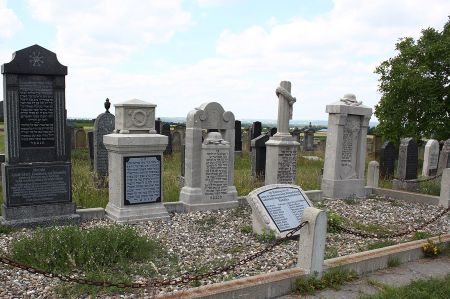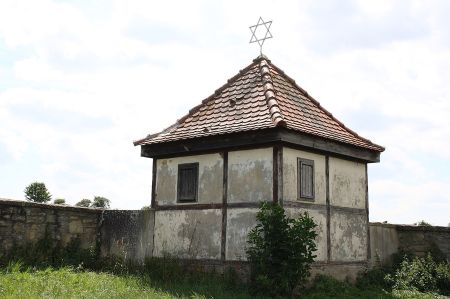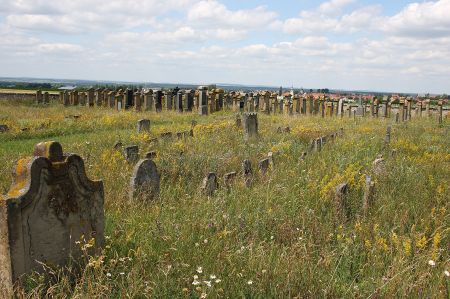The Jewish Cemetery in Rödelsee on Schwanberg
- Written by Portal Editor
During a visit to Kitzingen during the past year we had also driven up the nearby Schwanberg to take some photos of the vines and the surrounding countryside.
The elevated position had also afforded our view of a large walled compound that we later learned was a Jewish cemetery. Our interest was further increased when we were able to gather initial information about this Jewish cemetery, which is considered to be one of the largest in Bavaria.
Rödelsee Jewish Cemetery became the central burial place

The Jewish cemetery in Rödelsee was laid out in the 15th century and was first mentioned in 1432 and again in 1526. In 1563 the aristocratic landowner, namely Wilhelm Moritz von Hessberg, confirmed the existence of the Jewish cemetery. It is the year 1602 when the construction of the perimeter wall and the construction of a Tahara house are approved. The Rödelsee Jewish Cemetery became the central burial place for several surrounding Jewish communities, e.g. from Großlangheim, Hüttenheim, Kitzingen, Mainbernheim, Mainstockheim and Marktbreit. Due to several extensions, the first of which took place in 1614, the cemetery is divided into five cemeteries. In the 19th century there was another expansion, so that the total area of the cemetery was 188.30 ares, which can have more than 2,500 gravestones.

Unfortunately, this cemetery is also visited again and again by uninvited visitors, so that we also found the entrance gate locked. However, a notice board states that the key to the gate is available in Rödelsee so that visitors can enter the site. The visitor's book is also kept here, which, in addition to information about the cemetery, also expects information about the visitor. We give up the key and continue our tour around the outside of the site. To the left of the entrance is the younger part of the cemetery from the 19th/20th centuries. Century, easily recognizable by the less weathered tombstones. There is also a memorial for those who died in World War I.
The cemetery was desecrated several times before and during the Nazi era (newspaper articles document the year 1929, 1932, 1936). During the November pogrom of 1938, the small Tahara cottage was even set on fire. In 1950 it was finally demolished. The washing stone from the Taharahaus was disused as a memorial stone in 1950 and set up in the middle of the site. In 1981, however, this too was destroyed. In 1983 a new memorial stone was erected to commemorate the Jews from Rödelsee and the surrounding area who died during the Nazi era.
Historical outline
1432 and 1526 First mentions of the cemetery
1563 Wilhelm Moritz von Hessberg approved the cemetery "am Steig". (First documentary mention)
1602 Friedrich Albert von Hessberg approves the construction of a wall and a mortuary for the ritual washing of the corpse.
1614 Extension of the cemetery 19th century. Another extension around 1920 installation of a memorial for Jewish dead soldiers in the cemetery area
1929/1932/1936 desecration of cemeteries
November 10,1938 SS men set the morgue on fire
1939 Tombstones are knocked over and destroyed
1942 Closure of the cemetery
1945 repair work on stones and on the wall by formerly active National Socialists.
1950 demolition of the ruins of the morgue. The wash stone comes with an inscribed and erected as a memorial stone.
1981 Unknown persons destroyed the memorial stone.
press releases
The construction of a new cemetery hall and the renovation of the old Tahara house (1921)
Article in the magazine "Der Israelit" from September 1, 1921:
"Kitzingen, August 15 (1921). In the Israelite central cemeteries in Rödelsee, which according to the cadastre of the rent office existed 'from time immemorial', it was previously considered a great nuisance that the usual prayers and obituaries had to take place in the open air at funerals; it might have been the same The little house, several hundred years old, in which the ritual ablutions take place, is in a very dilapidated condition.It was thanks to a very well-known, generous donation from Mr. Julius Klugmann from New York and his wife Fränzi, the former of whom comes from Wiesenbronn, which belongs to the cemetery district possible to erect a contemporary, stately building and to thoroughly renovate the old house. The noble donors have earned a great merit and their names were immortalized for all time by a memorial plaque attached to the building."
Reports of the first desecration of a cemetery in November 1929
Cemetery desecration in Rödelsee (source: CV newspaper of November 8th, 1929). During the night of November 3rd and 4th, eleven gravestones were knocked over in the Israelite district cemetery in Rödelsee near Kitzingen, and eight of them were smashed by vandals. The grave monument of Rabbi Thalheimer from Mainbernheim is among those that were completely destroyed. The desecrated graves include five children's graves. The footprints point to Mainbernheim. Since a right-wing extremist meeting was recently held there, it is reasonable to assume that the act is a result of this incitement. The investigations were immediately taken up energetically. The cemetery administration has offered a reward of 500 marks for the arrest of the culprit.
Kitzingen (source: Bavarian Jewish Community Newspaper of November 15, 1929).
Michael Schneeberger and Christian Reuther wrote a book about the Rödelsee cemetery: "Nothing more to say and nothing to mourn. A Jewish cemetery in Germany." DM 36.00, Edition Hentrich
Please read as well:
